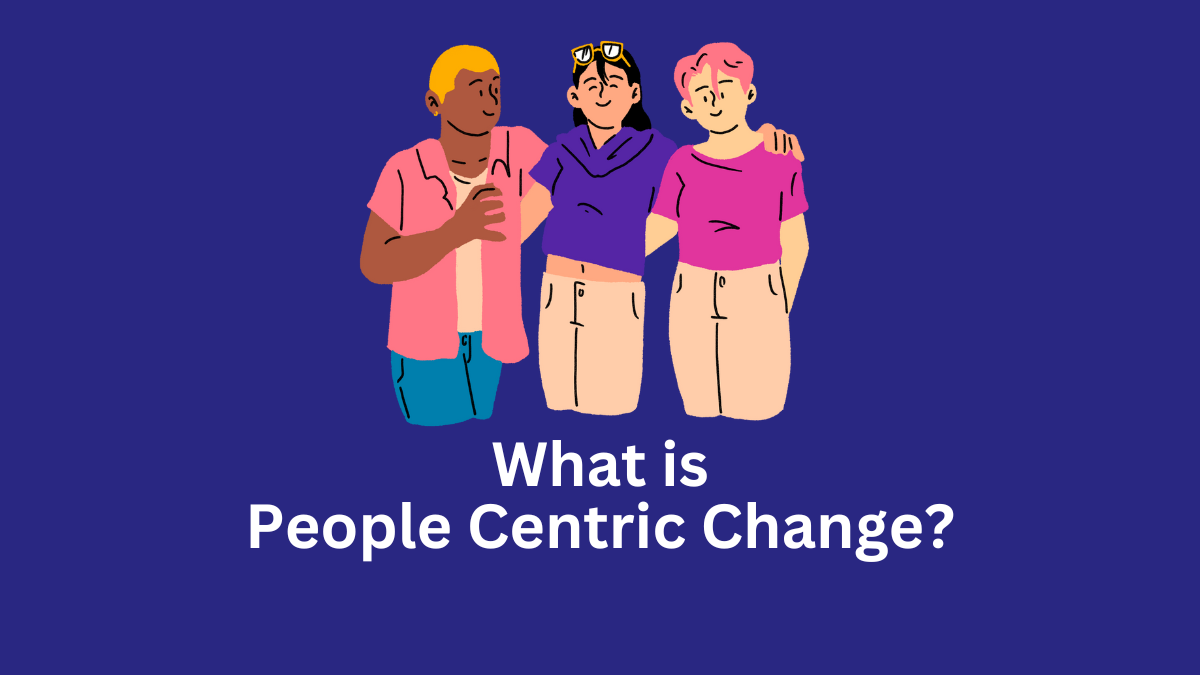What is People Centric Change?
People-centric change is a transformative approach to organizational change, emphasizing collaboration, empathy, and active involvement at all levels. Departing from traditional top-down models, it recognizes that individuals change for and with each other.
At its core, it prioritizes building trust through engagement, practicing participatory design, fostering continuous improvement, and empowering change leaders within the organization.
This approach acknowledges the psychological aspect of change, addressing resistance by understanding individual motivations, goals, and concerns. It goes beyond advertising-style campaigns, focusing on genuine dialogue, transparent communication, and feedback loops.
People-centric change strives to create a supportive environment where stakeholders, from leaders to team members, actively contribute to shaping and refining transformative initiatives. Ultimately, it seeks to democratize the change process, ensuring that every individual feels heard, valued, and motivated to embrace and drive organizational change.
Characteristics of People-Centric Change
People centric organizational change consists of the following key characteristics:
Empathetic Foundation
People-centric change begins with empathy, and understanding the concerns, motivations, and perspectives of individuals. It recognizes that change is a personal journey, and leaders must connect emotionally to address varying needs and resistances.
Inclusive Collaboration
The approach encourages collaboration at all levels, valuing input from leaders, team members, and stakeholders. Inclusivity fosters a sense of ownership, making individuals active contributors to the change process, and ensuring diverse perspectives are considered.
Transparent Communication
Transparent and clear communication is pivotal. Leaders communicate openly about the change’s purpose, benefits, and potential challenges. This helps build trust, manage expectations, and reduce uncertainties, fostering a positive environment.
Continuous Feedback Loop
People-centric change embraces feedback as a continuous loop. It acknowledges that insights from stakeholders, especially those directly impacted, are invaluable. Regular feedback ensures adjustments, improving the change process iteratively.
Adaptive Leadership
Leaders play a crucial role in adaptive leadership. They empower change leaders within the organization, actively involve employees in decision-making, and demonstrate flexibility in responding to evolving needs, making the change process dynamic.
Cultivation of Change Leaders
Identifying and empowering change leaders across all levels is a distinctive feature. These individuals, regardless of formal hierarchy, actively participate in shaping and guiding the change. They lead by example, showcase successful adaptation, and provide constructive criticism, contributing to the change’s success.
Read More: What is Strategic Organizational Change?
Pros and Cons of People Centric Change
While this organizational change approach is effective it shares both positive and negative aspects. People centric change pros and cons are mentioned below:
Pros:
- Enhanced Employee Engagement: People-centric change fosters active participation, making employees feel valued. This engagement positively impacts morale, productivity, and commitment to the organization’s goals.
- Higher Adaptability: Considering individual perspectives and needs facilitates smoother transitions. Employees are more likely to embrace and adapt to change when their concerns are addressed, contributing to overall organizational flexibility.
- Improved Innovation and Creativity: Inclusivity encourages diverse thinking and ideas. People-centric change unlocks the innovation potential, as individuals feel empowered to share insights, contributing to creative problem-solving.
- Stronger Organizational Culture: This approach reinforces a positive culture built on trust and transparency. When employees feel heard and valued, it strengthens their sense of belonging and commitment to shared values.
- Increased Employee Retention: By prioritizing individual needs, people-centric change creates a supportive work environment. This, in turn, reduces turnover rates as employees are more likely to stay in an organization that cares about their well-being.
Cons:
- Time-Consuming Process: Soliciting and incorporating diverse opinions and feedback can be time-consuming. Balancing inclusivity with the need for timely decision-making poses a challenge.
- Resistance from Traditionalists: Individuals resistant to change may resist the people-centric approach. Those accustomed to traditional top-down models may find it challenging to adapt to a more collaborative and inclusive process.
- Potential for Decision Paralysis: In an attempt to include everyone, there’s a risk of decision paralysis. Too much emphasis on consensus may lead to delays and indecision, hindering the progress of the change initiative.
- Difficulty in Measurement: Quantifying the success of people-centric change in concrete terms can be challenging. Metrics like employee satisfaction and engagement are subjective, making it difficult to assess the initiative’s overall impact in quantifiable terms.
Read More: 4 Major Areas of Organizational Change
Strategies To Implement People Centric Change
So far we understood people-centric change and its pros/cons. Now, let’s explore some strategies to effectively implement people-centric change in the organization.
Embrace Inclusive Decision-Making
Foster a culture of inclusive decision-making by involving employees at various levels in the change process. This ensures diverse perspectives are considered, promoting a sense of ownership and commitment.
Effective Communication Channels
Establish transparent and multi-channel communication to keep employees informed about the change. Utilize newsletters, meetings, webinars, and informal discussions to share the rationale, benefits, and progress of the change initiative.
Read More: What is Unplanned Change?
Empower Change Leaders
Identify and empower change leaders within the organization. These individuals, whether formally or informally recognized, play a crucial role in guiding others through the change. They provide practical examples of successful adaptation and offer constructive criticism for improvement.
Participatory Design and Piloting
Involve employees in the design process, seeking their input on proposed changes. Implement pilot programs that allow individuals to experience the new environment or processes firsthand, gathering valuable feedback for refinement.
Build Trust through Engagement
Recognize and address potential resistance by building trust through engagement. Understand employees’ motivations, goals, and concerns. This empathetic approach helps mitigate loss aversion and fosters a positive attitude toward change.
Continuous Feedback and Adaptation
Establish mechanisms for continuous feedback throughout the change journey. Encourage open dialogue and adapt the change plan based on insights and concerns raised by employees. Flexibility and responsiveness enhance the overall effectiveness of people-centric change.
Read Next: What is Deming Management?

Sujan Chaudhary holds a Bachelor in Business Administration (BBA) degree and is currently pursuing an MBA degree. He loves to share his business knowledge with the rest of the world.
